I’ve admired Elsa Mora’s work for quite some time. She has a new blog called All About Papercutting, with examples, reviews, tutorials and supplies for sales. Below is Elsa’s newest miniature book.
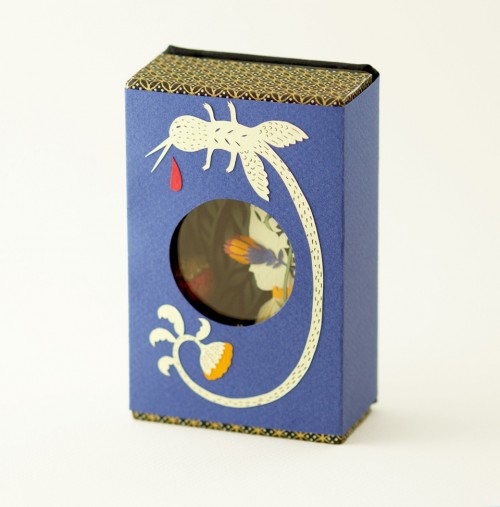
I love paper and my studio is filled with sheets of all sorts — patterned, colored, textured, plain, and lots of different weights. And there’s a big drawer full of sample books. I’m always looking for new paper sources and experimenting with the paper I have.
I’ve admired Elsa Mora’s work for quite some time. She has a new blog called All About Papercutting, with examples, reviews, tutorials and supplies for sales. Below is Elsa’s newest miniature book.

Helen Hiebert is doing a paper weaving every day until she reaches 100. She started on Sep 23. Here’s one of them. You can see all on her pinterest board or follow her progress on her blog. All the designs are really quite varied!
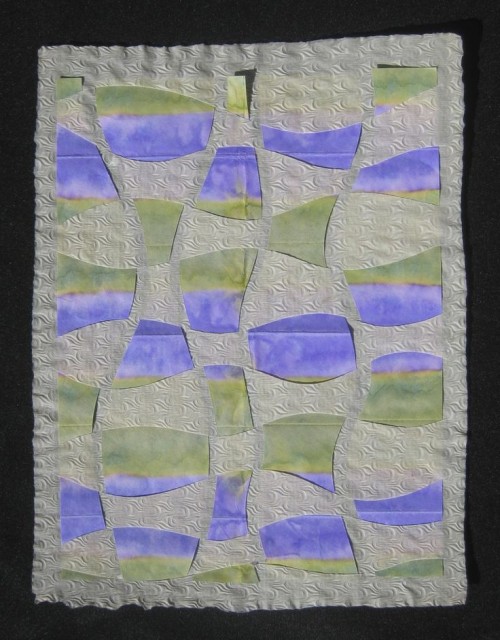
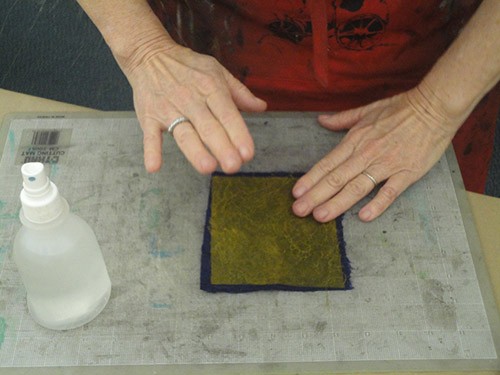
As I wrote here, this past June I attended the Focus on Book Arts conference and took Aimee Lee’s class “Paper like leather, Bark like thread: Korean Paper Techniques.” One of the techniques was joomchi, or paper felting. While time consuming, it was much simplier than, say, needle felting, and didn’t result in pricked fingers.
![]() By adding water to hanji (Korean-made paper), you can adhere 2 pieces of paper together, just by patting and pounding on them. That’s what I’m doing in the photo above. Western paper would fall apart with this technique, but hanji is a very long fiber paper and holds together, even when soaking wet. Below are the results from some of my classmates.
By adding water to hanji (Korean-made paper), you can adhere 2 pieces of paper together, just by patting and pounding on them. That’s what I’m doing in the photo above. Western paper would fall apart with this technique, but hanji is a very long fiber paper and holds together, even when soaking wet. Below are the results from some of my classmates.
![]() Small squares of blue hanji have been adhered to white hanji.
Small squares of blue hanji have been adhered to white hanji.
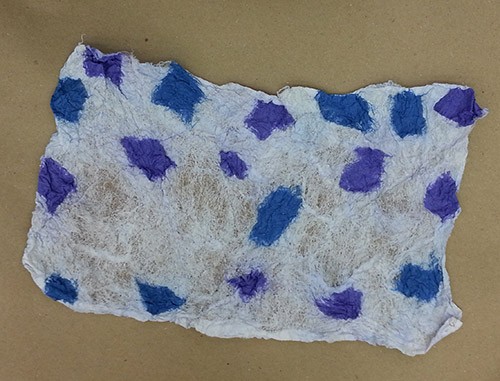
Bark lace (made from kozo, see my post here) adhered to black hanji.

Below, tiny pieces of colored hanji (almost lint) have been adhered to a large parent sheet of hanji. The result was cut down into very long strips and then knitted.
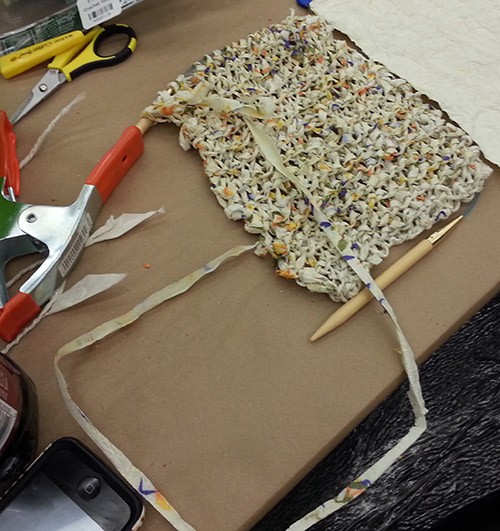
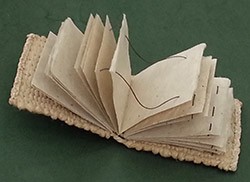 In June, I attended the Focus on Book Arts conference, and took Aimee Lee’s class “Paper like leather, Bark like thread: Korean Paper Techniques.” Over 3 days, we were introduced to various traditional Korean techniques of manipulating handmade paper and bark. One technique was jiseung, or paper weaving, which transforms strips of paper into cords that can be twined into all manner of objects, including baskets and book covers, like the one on the left.
In June, I attended the Focus on Book Arts conference, and took Aimee Lee’s class “Paper like leather, Bark like thread: Korean Paper Techniques.” Over 3 days, we were introduced to various traditional Korean techniques of manipulating handmade paper and bark. One technique was jiseung, or paper weaving, which transforms strips of paper into cords that can be twined into all manner of objects, including baskets and book covers, like the one on the left.
First Aimee boiled long pieces of kozo, the inner bark of the paper mulberry tree, which has long and strong fibers. After it was soft, we each got a piece to play with. The picture below is “bark lace,” where the fibers are tweezed apart to make a lacy pattern. Single strands can be pulled off to make thread.
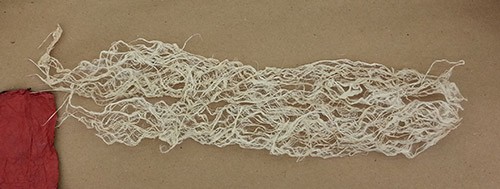
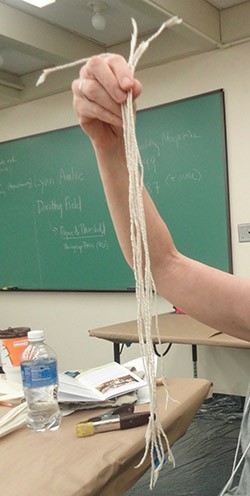 Then we cut parent sheets of hanji (paper made with kozo in the Korean technique) into long strips, and made two-ply cords out of them, by rubbing 2 strips together in our palms. I think we made 16, enough practice to really get the hang of the motions required to twine the strips as well as to get even tension (something I finally got on the last 2 cords). Here are my first attempts… Then we cut parent sheets of hanji (paper made with kozo in the Korean technique) into long strips, and made two-ply cords out of them, by rubbing 2 strips together in our palms. I think we made 16, enough practice to really get the hang of the motions required to twine the strips as well as to get even tension (something I finally got on the last 2 cords). Here are my first attempts…
|
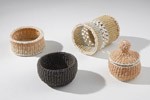 Then Aimee showed us how weave the cords (using a basket weave) to make “book covers.” In the picture below, I have reached then end of the cover—the non-woven space in the middle is for the spine of the book. As a non-crocheter, non-knitter and non-weaver, this was all a bit foreign. You can see I’ve dropped (or missed) some stitches, but I quite liked the handwork and repetition. Aimee showed us how to make a round basket as well, but I decided to make several book covers instead so I would be able to replicate the weave at home. While the class was working away. Aimee collected up all our scrap cords and made exquisite little baskets—no more than an inch wide, like the ones to the right.
Then Aimee showed us how weave the cords (using a basket weave) to make “book covers.” In the picture below, I have reached then end of the cover—the non-woven space in the middle is for the spine of the book. As a non-crocheter, non-knitter and non-weaver, this was all a bit foreign. You can see I’ve dropped (or missed) some stitches, but I quite liked the handwork and repetition. Aimee showed us how to make a round basket as well, but I decided to make several book covers instead so I would be able to replicate the weave at home. While the class was working away. Aimee collected up all our scrap cords and made exquisite little baskets—no more than an inch wide, like the ones to the right.
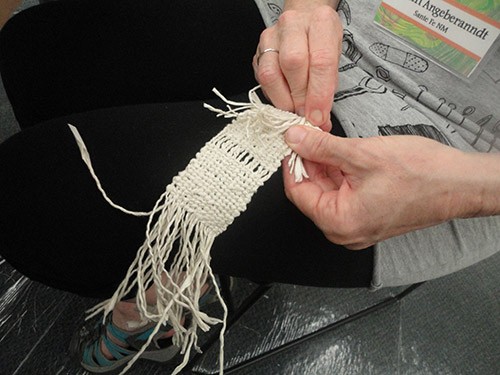
After the cover was done, I decided to cut my bark lace into “pages” and sew them, using the kozo thread, into the spine of the book. A completely hanji book… (I wasn’t quite done when the picture was taken, and that’s the kozo thread hanging off the back)
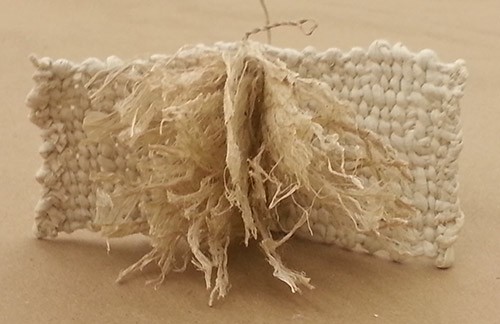
I like it very much because it is so unlike my other work—the cover is soft and unformed, the inside brittle. It’s not overly thought-out. Aimee told us that Koreans have used paper from books and official documents (with text on them) to weave baskets and animals and other forms, and this got to be a problem because people were stealing important papers to use in the weaving. I’m planning on letterpress printing secrets or poetry on large sheets of hanji, cutting them down, twining them and weaving to see what I get.
![]() Below is the book made by my table-mate Julie. She makes paper and knows how to knit, crochet, and weave. And she makes baskets. This could have been daunting, but she was really helpful when my fingers & brain refused to be coordinated and got me unstuck numerous times. She used her own paper for the inside of her book, and she died the cords with her own handmade dye before she wove the cords.
Below is the book made by my table-mate Julie. She makes paper and knows how to knit, crochet, and weave. And she makes baskets. This could have been daunting, but she was really helpful when my fingers & brain refused to be coordinated and got me unstuck numerous times. She used her own paper for the inside of her book, and she died the cords with her own handmade dye before she wove the cords.
This summer I’m taking a korean paper making class from Aimee Lee. She takes the paper she makes and knits it into books. Here are a couple to give you an idea of what she’s doing. There are lots more, as well as her other work, on her website.
The table next to mine at Codex was Horse and Buggy Press, from Durham, North Carolina. Dave designed and printed a lovely book of sonnets by Kathryn Stripling Byer called “Southern Fictions.” The sonnets reflect on the racial conflict in Southwest Georgia when Byer was growing up during the Jim Crow era. Dave hand-made some of the paper, including the cover and front piece (below) out of confederate flags. He has a nice blog post about making the paper and printing the book here.